Kia Stinger: Forward Collision-avoidance Assist (FCA) / Limitation of the system
The FCA system is designed to monitor the vehicle ahead or a pedestrian on the roadway through radar signals and camera recognition to warn the driver that a collision is imminent, and if necessary, apply emergency braking. In certain situations, the radar sensor or the camera may not be able to detect the vehicle or pedestrian ahead. In these cases, the FCA system may not operate. The driver must pay careful attention in the following situations where the FCA operation may be limited:
Recognizing vehicles
The sensor may be limited when:
- The radar or the camera is contaminated with foreign substances.
- It heavily rains or snows.
- There is electromagnetic interference.
- Something in the path of travel deflects the radar waves.
- The vehicle in front has a narrow body. (i.e. motor cycle and bicycle)
- The driver's view is not clear due to backlight, reflected light, or darkness.
- The camera cannot contain the full image of the vehicle in front.
- The vehicle in front is a special vehicle, such as a heavily-loaded truck or a
trailer.
- The outside brightness is greatly changed, such as entering/exiting a tunnel.
- The vehicle driving is on a rough or bumpy road.
- The radar/camera sensor recognition is limited.
- The vehicle in front is driving erratically
- The vehicle is driven near areas containing metal substances such as a construction
zone, railroad, etc.
- Moisture on the windshield is not completely removed or frozen.
- The weather is misty.
- The vehicle in front does not turn ON the rear lights, does not have rear lights,
has asymmetric rear lights, or has rear lights out of angle.
- The vehicle is on unpaved or uneven rough surfaces, or roads with sudden gradient
changes.
- The vehicle is moving under ground level or inside a building.
- If a sudden change in the sensor recognition takes place while driving over a
speed bump,
- When the vehicle is severely shaken,
- When driving around a circular intersection with a vehicle or object in front.
- If the front of the camera lens is contaminated by front glass tinting, film,
water repellent coating, damage on glass, or foreign matter (sticker, insect, etc.)
- The radar or camera or camera lens is damaged.
- If the headlights of the vehicle are not used at night or in a tunnel section,
or the light is too weak
- If street light or the light of a vehicle coming from the opposite direction is
reflected or when sunlight is reflected by water on the road surface
- When the back light is projected in the direction of the vehicle's motion (including
the headlights of vehicles)
- Road sign, shadow on the road, tunnel entrance, toll gate, partial pavement
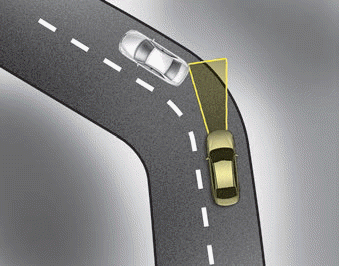
- Driving on a curve
The FCA performance may be limited while driving on a curve. The FCA may not recognize the vehicle in front even if in the same lane. It may produce the warning message and the warning alarm prematurely, or it may not produce the warning message or the warning alarm at all. When driving on a curve, exercise caution, maintain a safe braking distance, and if necessary, depress the brake pedal to reduce your driving speed in order to maintain a safe distance.
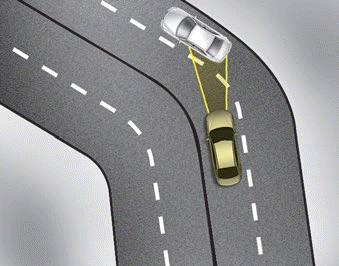
The FCA system may recognize a vehicle in an adjacent lane when driving on a curved road. In this case, the system may apply the brake. Always pay attention to road and driving conditions while driving. If necessary, depress the brake pedal to reduce your driving speed in order to maintain a safe distance. Also, when necessary, you may depress the accelerator pedal to prevent the system from unnecessarily decelerating your vehicle. Always check the traffic conditions around the vehicle.
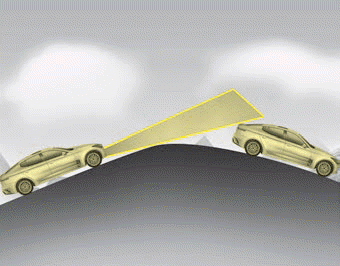
- Driving on a slope
The FCA performance may be limited while driving upward or downward on a slope, and may not recognize a vehicle in front in the same lane. It may produce the warning message and the warning alarm prematurely, or it may not produce the warning message and the warning alarm at all.
When the FCA suddenly recognizes the vehicle in front while passing over a slope, you may experience sharp deceleration.
Always keep your eyes forward while driving upward or downward on a slope, and, if necessary, depress the brake pedal to reduce your driving speed in order to maintain a safe distance.
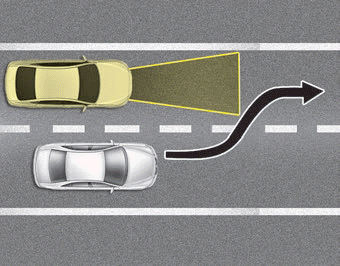
- Changing lanes
When a vehicle changes lanes in front of you, the FCA system may not immediately detect the vehicle, especially if the vehicle changes lanes abruptly. In this case, you must maintain a safe braking distance, and if necessary, depress the brake pedal to reduce your driving speed in order to maintain a safe distance.
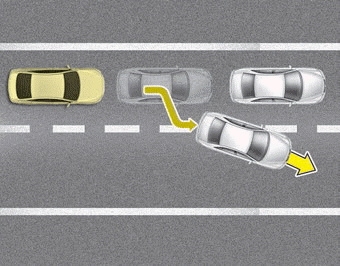
When driving in stop-and-go traffic, and a stopped vehicle in front of you merges out of the lane, the FCA system may not immediately detect the new vehicle that is now in front of you. In this case, you must maintain a safe braking distance, and if necessary, depress the brake pedal to reduce your driving speed in order to maintain a safe distance.
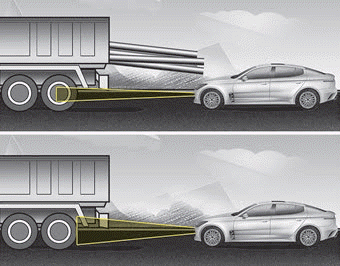
- Recognizing the vehicle
If the vehicle in front of you has cargo that extends rearward from the cab, or when the vehicle in front of you has higher ground clearance, additional special attention is required. The FCA system may not be able to recognize the cargo extending from the vehicle. In these instances, you must maintain a safe braking distance from the rearmost object, and if necessary, depress the brake pedal to reduce your driving speed in order to maintain distance.
Recognizing pedestrians
The sensor may be limited when:
- The pedestrian is not fully detected by the camera recognition system, for
example, if the pedestrian is leaning over or is not fully walking upright
- The pedestrian is moving very quickly or appears abruptly in the camera detection
area
- The pedestrian is wearing clothing that easily blends into the background, making
it difficult to be detected by the camera recognition system
- The outside lighting is too bright (e.g. when driving in bright sunlight or in
sun glare) or too dark (e.g. when driving on a dark rural road at night)
- There is an item similar to a person's body structure
- The pedestrian is small
- The pedestrian has impaired mobility
- The sensor recognition is limited - It is difficult to detect and distinguish
the pedestrian from other objects in the surroundings, for example, when there is
a group of pedestrians or a large crowd
- If a sudden change in the sensor recognition takes place while driving over a
speed bump,
- When the vehicle is severely shaken,
- When driving around circular intersection,
- If the front of the camera lens is contaminated by front glass tinting, film,
water repellent coating, damage on glass, or foreign matter (sticker, insect, etc.)
- The radar or camera or camera lens is damaged.
- If the headlights of the vehicle are not used at night or in a tunnel section,
or the light is too weak
- If street light or the light of a vehicle coming from the opposite direction is
reflected or when sunlight is reflected by the water on the road surface
- When the back light is projected in the direction of the vehicle's motion (including
the headlights of vehicles)
- Road sign, shadow on the road, tunnel entrance, toll gate, partial pavement
- If the moist on the front windshield is not entirely removed or it is frozen
- The weather is foggy
- The radar/camera sensor recognition is limited.
WARNING
The FCA cannot avoid all collisions. The FCA might not completely stop the vehicle before a collision, due to ambient weather and road conditions. The driver has the responsibility to drive safely and control the vehicle.
WARNING
- Do not use the FCA system when towing a vehicle. Cancel the FCA in the User Settings on the LCD display before towing. Brake application by the FCA system while towing may adversely affect your safety.
- Use extreme caution when the vehicle in front of you has cargo that extends rearward from the cab, or when the vehicle in front of you has higher ground clearance.
- The FCA system is designed to detect and monitor the vehicle ahead or detect a pedestrian in the roadway through radar signals and camera recognition. It is not designed to detect bicycles, motorcycles, or smaller wheeled objects such as luggage bags, shopping carts, or strollers.
✽ NOTICE
In some instances, the FCA system may be canceled when subjected to electromagnetic interference.
• When replacing or reinstalling the windshield, front bumper or radar/camera after removal, have the vehicle inspected by an authorized Kia dealer.
 System malfunction
System malfunction
When the FCA is not working properly, the FCA warning light ()
will illuminate and the warning message will appear for a few seconds. After
the message disappears, the master warning light ...
 Cruise control system
Cruise control system
The cruise control system allows you to program the vehicle to maintain a constant
speed without depressing the accelerator pedal.
This system is designed to function above approximately 30 km/h ...
Other information:
Kia Stinger CK 2018-2025 Owners Manual: Driver position memory system
Driver Position Memory System is the facility that enables driver’s seat, leg extension, steering wheel, exterior mirrors, cluster and head-up display (HUD) to be controlled with a simple button operation, which allows a driver to recall memorized driving positions and automatically contro ...
Kia Stinger CK 2018-2025 Owners Manual: Road warning
Hazard warning flasher The hazard warning flasher serves as a warning to other drivers to exercise extreme caution when approaching, overtaking, or passing your vehicle. It should be used whenever emergency repairs are being made or when the vehicle is stopped near the edge of a roadway. De ...
